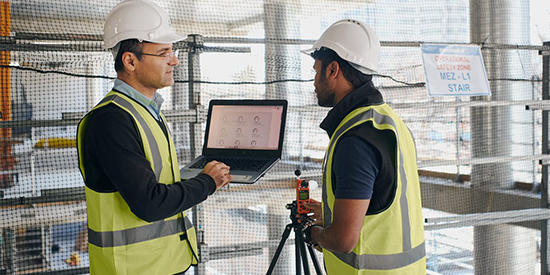World-first trial to help build COVID-safe construction
Research news
Construction workers at two of Victoria's largest worksites put a range of personal wearable temperature sensors to the test during June and July in a world-first trial that is likely to boost the COVID-safe credentials of Australia's $360 billion construction industry.
The multi-disciplinary research team from Deakin University's Schools of Architecture and Built Environment, and Information Technology tested four different wearable sensors – an ear sensor, axillary sensor, vest, and the Oura ring – on 30 workers over three weeks.
The research team was led jointly by Industry Professor Tony Arnel, president of the Energy Efficiency Council and Dr Farnad Nasirzadeh, Senior Lecturer in the School of Architecture and Built Environment.
Industry Professor Arnel said this unique research had the prospect of improving workplace health and safety and was an impressive collaboration between the building industry unions and the employers.
Dr Nasirzadeh, a leader in improving health and safety in construction workplaces, explained that the trial results were very promising, in terms of both accuracy and comfort for the workers. The personal sensors provided more reliable data than the infrared thermometers currently being used to screen construction workers as they enter worksites.
"The infrared thermometers provide an unreliable detection of fever symptoms due to the variations in skin temperature throughout the day," Dr Nasirzadeh said.
"The personal sensors we tested were customised for construction workers to consider the effects of physical activities and ambient conditions on body temperature, in addition to the temperature fluctuations throughout the day."
The sensors provided real-time temperature readings every minute, with the data validated by hospital-grade thermometers. The data was then shown on a custom-built advanced temperature monitoring dashboard which included an alert system.
"The alert system sends a notification to the responsible person if an employee's temperature hits a specified threshold," Dr Nasirzadeh said.
Industry Professor Tony Arnel said that now the data collection phase has been completed, the researchers are keen to move to the next phase of the project that will see wider benefit to the construction industry.
"Thanks to financial support from Incolink, we had 10 construction workers test the sensors while on the job at Kane Constructions' worksite at 60 Moorabool Street in Geelong, the new home of GMHBA’s headquarters," Professor Arnel said.
"We also had 20 workers putting the sensors through their paces at the construction site of CSL's new global headquarters at 645 Elizabeth Street, which is being managed by Probuild.
"Once we've fully analysed the data to find the most accurate and comfortable option, we'll begin the project implementation phase, where the devices will be worn by a large number of construction workers across Victoria.
"Ultimately, we hope that the wearable technology will aid our understanding of the early signs of coronavirus in the next stage of the project and help Australia's construction industry keep moving forward as we all learn to live in a COVID-19 world."
Dr Chandan Karmakar, Senior Lecturer in Deakin’s School of IT and one of the chief investigators for the trial, led the development of the data collection framework and temperature monitoring dashboard, which links to the sensors.
"The advanced monitoring dashboard and alerting system that will be developed in the project implementation phase will not only detect symptoms of COVID in real time, but also will help to monitor the changes in conditions of infected workers while they are in isolation," Dr Karmakar said.
Further information:
Share this story

Key Fact
Dr Farnad Nasirzadeh (left) is working to create safer workplaces in construction.
